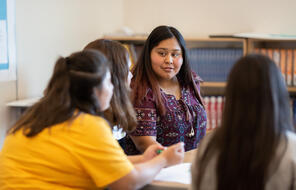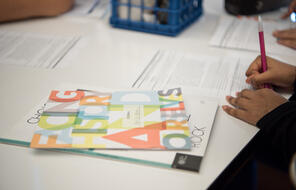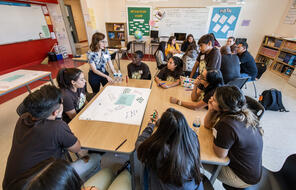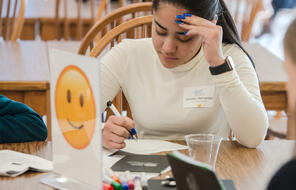Métis
Much like the term Indian, the word Métis is a European term (French for “mixed”) that refers to indigenous people of French or British descent. While the French-speaking and English-speaking groups were previously distinct, today the Métis identity more broadly includes people of mixed First Nations descent and both European heritages. Historically, Métis served as the middlemen between European merchants and indigenous people. The majority of them lived in communities along the routes of the colonial trade, from Ontario westward. Many now reside in urban communities. The Métis did not have official group recognition as Aboriginal Peoples until the Constitution Act of 1982, and they were therefore a “non-people” according to the federal government.
The Métis themselves responded to their marginalization by adopting symbols to reinforce a collective identity and create a sense of pride. For instance, the Métis flag, either red or blue with an infinity symbol, represents the joining of the mixed parent nations. While some adhere to their ancestral spiritualism and others to forms of Christianity, many Métis blend Christianity with indigenous spirituality.
As a result of the trade relationships, marriages, and cultural exchanges that developed between the settlers and the First Nations inhabitants, the native languages organically adapted to include European words and structures (as did the European language, but to a lesser degree). Michif, the Métis-French language, is one of the most prominent evidences of the fusion of two cultures. This unique language combines verbs from Cree, Ojibway, and other First Nations languages with French nouns and other phrases. Michif was widely used throughout the regions in which Métis people lived and worked. But First Nations languages are in decline among the Métis. While many Métis were multilingual, speaking French or English, First Nations languages such as Cree or Saulteaux, and, often, Michif, there are only 600 speakers of Michif alive today. 1
Guy A. Lavallée is a Métis priest who conducted a series of 65 interviews while investigating the origins of Michif in the St. Laurent, Manitoba, region. 2 He suggests that there is no direct evidence that can explain how Michif took shape. But much is known today about how Creole languages (or “pidgin dialects”) are created when two cultures interact. Many of them were forged in a colonial context where outside settlers interacted with two or more ethnic groups and thought a simplified, common language would facilitate trade and communication. A classic example is the French-based language called Haitian Creole, which emerged in the eighteenth century as the result of the daily contacts between French settlers and slave owners and their African slaves. 3
In the following passage, one of the interviewees, a Métis elder named Frank Ducharme, reflects upon the development of the Michif language. In an interview, Ducharme follows a tradition of storytelling by narrating in the first person the history of Michif. Like other elders interviewed by Lavallée, Ducharme places the beginning of the language, which is distinct from French or indigenous languages, in the early 1800s:
I have a theory about the origin of our language that we speak and it goes this way: It is, say, in the year 1800 at Red River. This French fur trader who works for the Northwest Company meets this beautiful Indian woman. They get together and, nine months later, I am born. My French father has to leave the household to hunt and trap the furs for the Company; sometimes he is gone for two or three months at a time. In the meantime, I am at home alone with my mother, who does not understand a word of French but who continually speaks to me in her mother tongue, either Saulteaux or Cree. I grow up learning my mother’s language. When my father comes home from the hunt, he speaks to me in his language, which is French: he does not know either Saulteaux or Cree. So, I grow up learning both an Indian language and the French language. As I interact and play and speak with other children who were in the same situation as I was, we develop this new language, called Michif French.
Connection Questions
- How does the development of the Michif language, as Frank Ducharme describes it, illustrate the way he sees Métis heritage?
- What does Ducharme’s story suggest about the origin of Michif? What does it suggest about the development of languages? About the development of languages in real life?
- 1Kevin Ma, “Researcher digs into near-extinct Métis language,” St. Albert Gazette, March 13, 2013, accessed September 18, 2014.
- 2Guy A. Lavallée, “The Michif French Language: Historical Development and Métis Group Identity and Solidarity at St. Laurent, Manitoba,” Native Studies Review 7 (1991), 84.
- 3Salikoko S. Mufwene, “Pidgin and Creole Languages,” International Encyclopedia of the Social and Behavioral Sciences.
How to Cite This Reading
Facing History & Ourselves, “Métis”, last updated September 20, 2019.
















